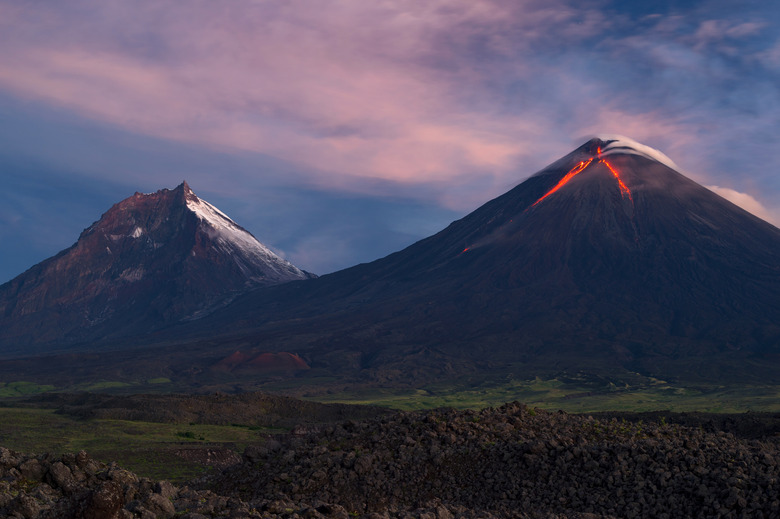Facts About Cinder Cones
As far as "fire mountains" go, cinder cones aren't terribly big, but they certainly embody the classic form of a stereotypical volcano: conical, steep-sided and usually topped with a crater. These pointy buttes pepper many volcanic provinces of the world, whether rising low from extensive lava plains or studding the flanks of bigger types of volcanoes.
Defining a Cinder Cone
Defining a Cinder Cone
Cinder cones form when a volcanic vent emits fountains of basaltic or andesitic lava in enough quantity for enough time to form a flanking mound of erupted rubble. "Cinder" refers to the chunks of lava that, solidifying instantly upon being ejected, compose that rubble. Gases rapidly escaping the fountaining lava create holes often preserved in these petrified fragments; geologists also call such porous volcanic rock "scoria," which explains why cinder cones also go by "scoria cones."
More generally, you might see cinder cones called "pyroclastic cones." "Pyroclastic" – aka "fire-broken rock" – refers to rocks derived from lava erupted as molten shreds. When pyroclastic material flies out of a volcano into the air, it's called "tephra," which encompasses everything from tiny grains of ash to giant blocks (or "bombs") of lava rock. Cinder cones as landforms are built entirely from tephra, though they also often release flowing lava as well.
Size, Shape and Form
Size, Shape and Form
Cinder cones tend to be neatly conical in form: triangular in profile, circular at the base. They may be anywhere from dozens to hundreds of feet high, but they rarely exceed 1,200 feet or so from base to summit. The slopes of cinder cones tend to be in the vicinity of 35 degrees, dictated by the "angle of repose" – in other words, the sharpest pitch at which its volcanic fragments can lie without sliding downhill. The tops of cinder cones commonly cradle a crater.
Cinder Cone Eruptions
Cinder Cone Eruptions
Unlike shield or composite volcanoes, most cinder cones arise from single eruptive episodes – though those episodes can last decades – and, once those wind down, the cones tend not to erupt again. This makes them "monogenetic volcanoes." Nicaragua's Cerro Negro is both the youngest basaltic cinder cone in the Western Hemisphere and one of the most active known cinder cones on the planet, having erupted better than 20 times since its emergence in 1850. Lava doesn't only fountain from a cinder cone's vent; it also tends to flow outward from the cone, usually from its base. Large basalt flows such as these often mark the end of a cinder cone's eruptive "career."
Cinder Cone Settings
Cinder Cone Settings
Cinder cones often grow around standalone vents in volcanic fields, the resulting topography expressed as solitary or clustered cones rising out of flat-lying lava flows. But cinder cones may also develop from subsidiary vents opened on the shoulders of shield or composite volcanoes. Mauna Kea on the Big Island of Hawaii, one of the biggest shield volcanoes on Earth, boasts nearly 100 cinder cones on its broad, gentle slopes. Besides Cerro Negro, famous examples of cinder cones include Arizona's Sunset Crater – part of the San Francisco volcanic field – and Mexico's Parícutin, which abruptly emerged from a cornfield in 1943 and, closely monitored by scientists, grew past 1,000 feet in a nine-year eruptive period.
References
- U.S. Geological Survey: Principal Types of Volcanoes
- Fire Mountains of the West; Stephen L. Harris
- Volcanoes of the Earth; Fred M. Bullard
- Smithsonian Institution: Global Volcanism Program – Types & Processes Gallery
- Oregon State University: Volcano World – Negro, Cerro
- U.S. Geological Survey: Cinder Cone
Cite This Article
MLA
Shaw, Ethan. "Facts About Cinder Cones" sciencing.com, https://www.sciencing.com/cinder-cones-5816030/. 20 April 2018.
APA
Shaw, Ethan. (2018, April 20). Facts About Cinder Cones. sciencing.com. Retrieved from https://www.sciencing.com/cinder-cones-5816030/
Chicago
Shaw, Ethan. Facts About Cinder Cones last modified March 24, 2022. https://www.sciencing.com/cinder-cones-5816030/
